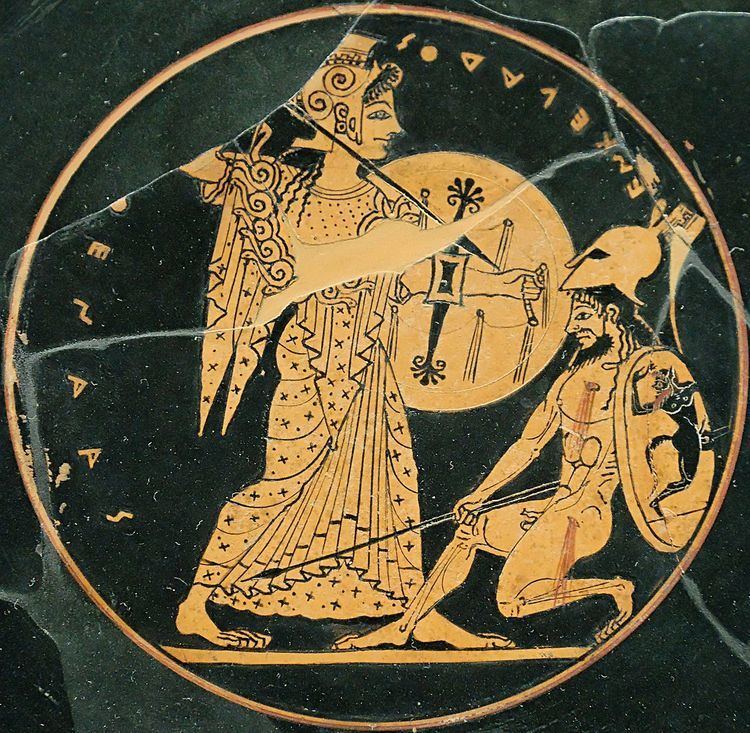 | ||
In Greek mythology, Enceladus (Ancient Greek: Ἐγκέλαδος Enkélados) was one of the Giants, the offspring of Gaia (Earth), and Uranus (Sky). Enceladus was the traditional opponent of Athena during the Gigantomachy, the war between the Giants and the gods, and was said to be buried under Mount Etna in Sicily.
Contents
Cause of volcanic eruptions and earthquakes
Enceladus (like other vanquished monsters, thought to be buried under volcanos) was said to be the cause of earthquakes and volcanic eruptions. Mount Etna's eruptions were said to be the breath of Enceladus, and its tremors to be caused by him rolling over from side to side beneath the mountain. So, for example Virgil:
the c. 1st century poem Aetna (perhaps written by Lucilius Junior):
and Claudian:
Ancient Art
The battle between Athena and Enceladus was a popular theme in Greek vase paintings, with examples from as early as the middle of the sixth century BC. We know, from the description given in Euripides' Ion, that the battle was depicted on the late sixth century BC Temple of Apollo at Delphi.
The east pediment of the Old Temple of Athena on the Acropolis of Athens, dating from the late sixth century, prominently displayed Athena standing over a fallen giant, possibly Enceladus. The battle was probably also depicted on the new peplos (robe) presented to Athena on the Acropolis of Athens as part of the Panathenaic festival.
The Dionysiaca
The fifth century AD Greek poet Nonnus, in his poem Dionysiaca, mentions Enceladus as one of the several Giants that Dionysus battles in the Gigantomachy. Nonnus has Gaia set the Giants against Dionysus, promising Enceladus Athena as his wife should the Giants subdue Dionysus. Dionysus fought Enceladus with fire, but Enceladus was ultimately defeated by Zeus: "[Dionysus] roasted the Giants' bodies with a great conflagration, an image on earth of the thunderbolt cast by Zeus. The torches blazed: fire was rolling all over the head of Encelados and making the air hot, but it did not vanquish him—Encelados bent not his knee in the steam of the eartly fire, since he was reserved for a thunderbolt."
In later art and literature
At Versailles, Louis XIV's consistent iconographic theme of the triumphs of Apollo and the Olympians against all adversaries included the fountain of Enceladus in its own cabinet de verdure, which was cut into the surrounding woodland and outlined by trelliswork; the ensemble has recently been restored (illustration). According to an engraving of the fountain by Le Pautre (1677), the sculptor of the gilt-bronze Enceladus was Gaspar Mercy of Cambrai.
William Shakespeare mentions "Enceladus" in Titus Andronicus, Act 4, sc. 2, L 96. "I tell you younglings, not Enceladus." (Folger Shakespeare Library – Titus Andronicus, page 136-137, copyright 2005).
John Keats mentions Enceladus among the Titans in his "Hyperion" (1818/1819).
In Herman Melville's Pierre, the image of Enceladus appears multiple times; the protagonist identifies with Enceladus in a dream.
Henry Wadsworth Longfellow, inspired by the suffering of the Second Italian War of Independence, wrote his poem "Enceladus" in 1859.
Rick Riordan included Enceladus in his book The Lost Hero as one of the primary villains.
Namesakes
Enceladus, a moon of the planet Saturn, is named after the mythological Enceladus. Its south pole is interspersed with massive geysers of ice and water vapor that shoot hundreds of miles from its interior. The moon is considered by scientists to be one of the most likely locations in the Solar System to offer some habitability potential for microscopic life.
One of two surviving Short Belfast military transport aircraft is dubbed "Enceladus".
In Antarctica, there is a grouping of Nunataks on Alexander Island called the Enceladus Nunataks — but these nunataks were named after Saturn's moon, not after the giants of Greek mythology.
